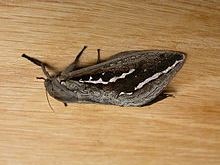Abantiades marcidus
(Abantiades marcidus)

Description
Abantiades marcidus is a moth of the family Hepialidae. It is endemic to Australia, where it is found in New South Wales, Queensland, South Australia and Victoria. The larvae are a favoured bait for fishing. Adults are grey-brown with variable white markings on the forewings. The hindwings are brown, fading to pale brown at the margins. The larvae are subterranean and feed on the roots of Eucalyptus species, living in a vertical tunnel closed off by a hinged lid. They ringbark the roots causing the plant to create a gall-like tissue, upon which they feed. The larvae are white with a brown head. Pupation takes place at the bottom of the tunnel. Abantiades is a genus of moths of the family Hepialidae. There are 14 described species, all found exclusively in Australia. The group includes some large species with a wingspan of up to 160 mm. The larvae feed on the roots of Eucalyptus and other trees. The Pindi moth (A. latipennis) is an abundant species of the eucalypt forests of Tasmania and, unlike many invertebrate species, appears to adapt well to the controversial forestry practice of clearfelling.
Taxonomic tree:







